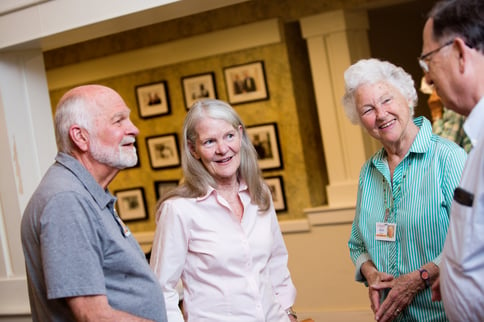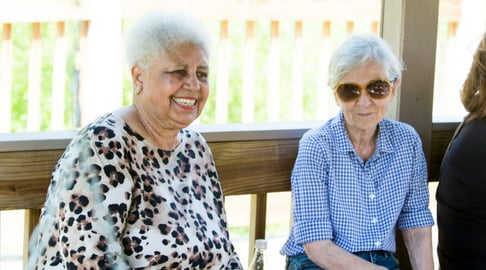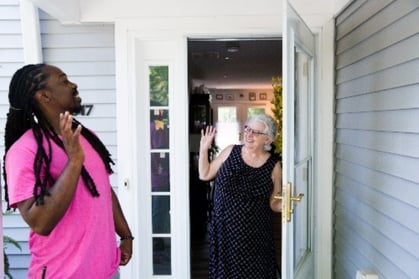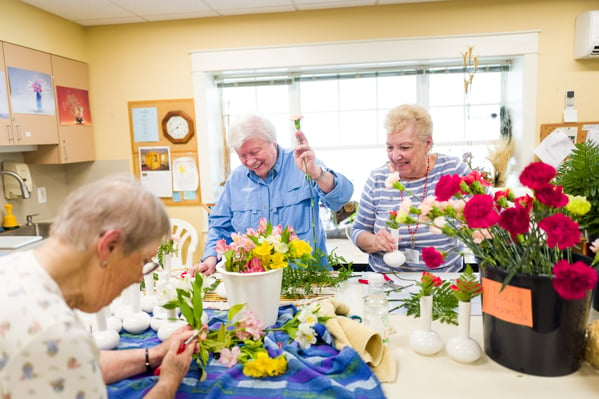Moving to a senior living community is a bit like going to college for the first time. It’s an exciting prospect, as there are virtually unlimited new activities and opportunities.
But it can also be a little scary.
Like first-time college students, older adults contemplating a move to senior living may wonder if they will make new friends.
Will They Be Nice to Me?
 Fears about cliques and unwelcoming residents are common among seniors and their families, sometimes with good reason.
Fears about cliques and unwelcoming residents are common among seniors and their families, sometimes with good reason.
Forming cliques is a natural part of human socialization, particularly among those in close proximity to one another. Groups of friends who either overtly or passively exclude others are not the sole domain of middle or high schoolers; they exist in all age groups, older adults included.
A 2014 study out of Weill Cornell Medical College and Cornell University found that clique behavior, a form of social bullying, is a sizable and growing problem as more and more retirement communities accommodate the growing senior population.
However, another more recent study of residents in senior housing found that while they were aware of social circles in their communities, most were happy and thriving, and cliques were not a source of dissatisfaction or stigma.
Intentional Inclusion
To be sure, being the “new kid on the block” can be intimidating at any age. But it needn’t be an obstacle to moving to a retirement community, where cultivating new friendships and interests is integral to the experience.
Quality communities like Collington prioritize inte ntional encouragement and welcoming of all residents.
ntional encouragement and welcoming of all residents.
Indeed, Kendal’s Quaker values emphasize inclusivity for all, regardless of race, color, gender, sexual orientation, religion or national origin. We treat each individual as a valued addition to the Collington family. In fact, our stated mission is “to thrive as a community of people living, working and serving together, bringing alive a spirit of collaboration, generosity and mutual respect in our relationships and decision-making.”
Unique among senior communities, our resident population is notably diverse; differences among individuals are celebrated and embraced. Geographically, roughly one-third of our residents come from within 15 minutes of our campus, another third from approximately 50 miles away, and the remaining third from places far and wide across the country.
Residents Helping Residents
Resident ambassadors, another feature of a community focused on inclusiveness, are one of the greatest resources for new Collington residents. These individuals understand first-hand the perspective of a new resident and can show them around, answer their questions, include them in meals and activities and help them transition smoothly into their new environment.
Here are just a few comments from real residents about companionship with their Collington peers:
 “I appreciate my fellow residents more than anything; they are what makes the experience so incredible. The people you meet living here will be your friends for the rest of your life.”
“I appreciate my fellow residents more than anything; they are what makes the experience so incredible. The people you meet living here will be your friends for the rest of your life.”
“I particularly like meeting new people in their neighborhood and at the community dining hall where they can participate in open dining and sit with different people every night.”
“Living here is so easy…and the people make it even better. I love the diversity and wide range of interests that everyone at Collington has.”
Supportive Staff
Many senior communities have policies and practices in place that prevent or address problems that arise from cliquey behavior.
 At Collington, friendly staff on our marketing, administration and facilities teams help onboard each new resident as a matter of course. In addition, our director of navigation (a licensed clinical social worker) is a great resource for residents who may have concerns about cliques or other issues on campus.
At Collington, friendly staff on our marketing, administration and facilities teams help onboard each new resident as a matter of course. In addition, our director of navigation (a licensed clinical social worker) is a great resource for residents who may have concerns about cliques or other issues on campus.
Resident district leaders are also available in each cluster neighborhood to hear and help resolve any concerns or conflicts. Even as residents are all connected to the central hub of activity on Collington’s 126-acre campus, our cottage clusters and apartment neighborhoods function like micro-communities of kindred people with whom to engage and bond.
A further support resource is the Collington Residents Association, an incorporated, non-profit organization comprised of all residents of the Collington Episcopal Life Care Community. This body serves several purposes, including representing residents’ views to management and the board of directors and developing reciprocally sound relations among residents, management and the board.
Get Involved Early
 Like adjusting to college life, acclimating to a senior community happens most easily with a willingness to get involved, try new things, introduce yourself and engage fellow residents in mutual conversations about your background and interests as well as theirs.
Like adjusting to college life, acclimating to a senior community happens most easily with a willingness to get involved, try new things, introduce yourself and engage fellow residents in mutual conversations about your background and interests as well as theirs.
Ask questions as often, or more, as you share about yourself. It’s a neuroscientific fact that people love to talk about themselves, and the more you engage others in their favorite topic, the sooner you’ll make the social connections so readily available in a vibrant senior community.
Find Your Thing
Even if it’s not your nature to be the most social person on campus (nor does it have to be – Collington residents are only as outgoing as they wish to be), it’s a good idea to begin this new chapter by exploring a few activities, events or causes suitable to your curiosities, passions or skills and life experiences.
Supporting this mindset of discovery are two other purposes of the Collington Residents Association, which are to “encourage and assist resident participation in educational, cultural and charitable activities in the outside community” and “to organize and perform activities on behalf of all residents.”





